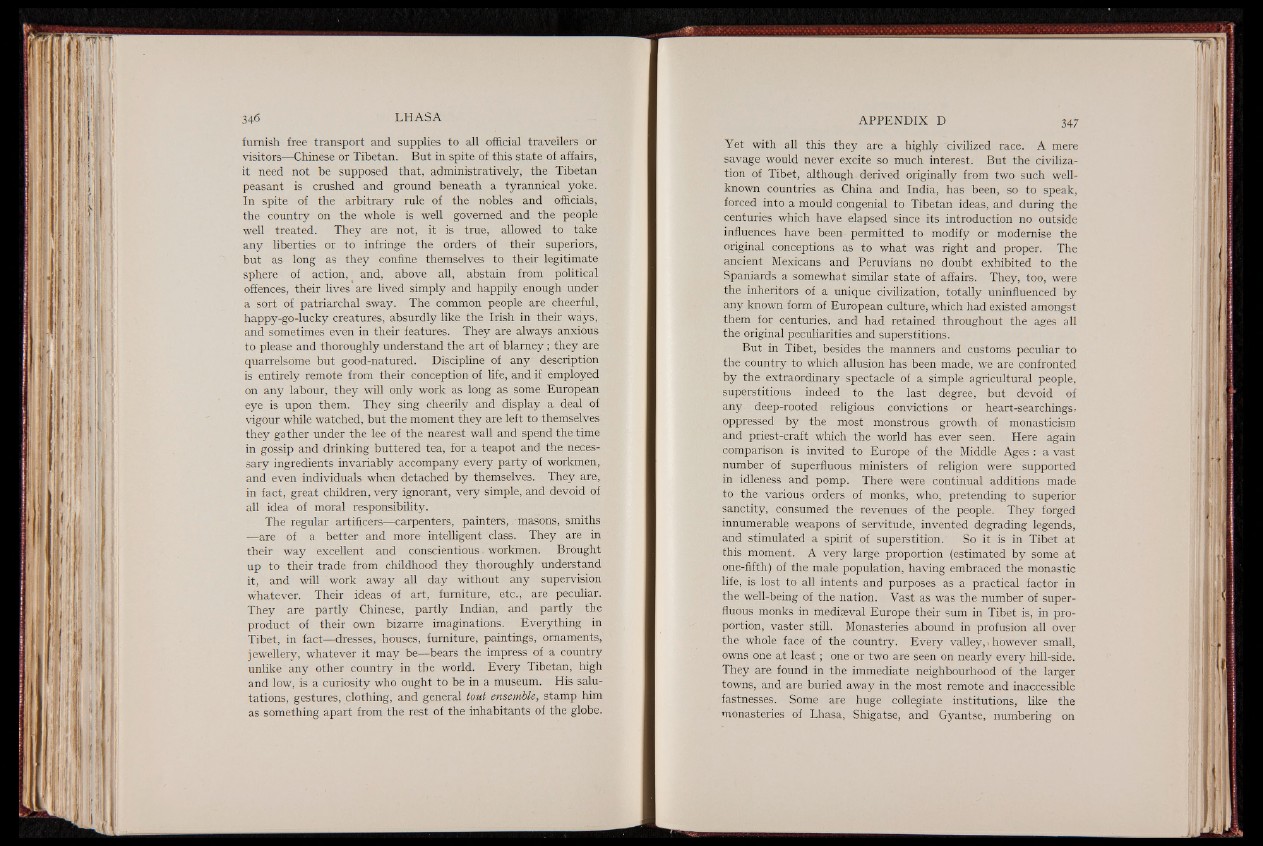
furnish free transport and supplies to all official travellers or
visitors— Chinese or Tibetan. But in spite of this state of affairs,
it need not be supposed that, administratively, the Tibetan
peasant is crushed and ground beneath a tyrannical yoke.
In spite of the arbitrary rule of the nobles and officials,
the country on the whole is well governed and the people
well treated. They are not, it is true, allowed to take
any liberties or to infringe the orders, of their superiors,
but as long as they confine themselves to their legitimate
sphere of action, and, above all, abstain from political
offences, their lives are lived simply and happily enough under
a sort of patriarchal sway. The common people are cheerful,
happy-go-lucky creatures, absurdly like the Irish in their ways,
and sometimes even in their features. They are always anxious
to please and thoroughly understand the art of blarney; they are
quarrelsome but good-natured. Discipline of any description
is entirely remote from their conception of life, and if employed
on any labour, they will only work as long as some European
eye is upon them. They sing cheerily and display a deal of
vigour while watched, but the moment they are left to themselves
they gather under the lee of the nearest wall and spend the time
in gossip and drinking buttered tea, for a teapot and the necessary
ingredients invariably accompany every party of workmen,
and even individuals when detached by themselves. They are,
in fact, great children, very ignorant, very simple, and devoid of
all idea of moral responsibility.
The regular artificers— carpenters, painters, . masons, smiths
— are of a better and more intelligent class. They are in
their way excelent and conscientious. workmen. Brought
up to their trade from childhood they thoroughly understand
it, and will work away all day without any supervision
whatever. Their ideas of art, furniture, etc., are peculiar.
They are partly Chinese, partly Indian, and partly the
product of their own bizarre imaginations. Everything in
Tibet, in fact— dresses, houses, furniture, paintings, ornaments,'
jewellery, whatever it may be— bears the impress of a country
unlike any other country in the world. Every Tibetan, high
and low, is a curiosity who ought to be in a museum. His salutations,
gestures, clothing, and general tout ensemble, stamp him
as something apart from the rest of the inhabitants of the globe.
Yet with all this they are a highly civilized race. A mere
savage would never excite so much interest. But the civilization
of Tibet, although derived originally from two such well-
known countries as China and India, has been, so to speak,
forced into a mould congenial to Tibetan ideas, and during the
centuries which have elapsed since its introduction no outside
influences have been permitted to modify or modernise the
original conceptions as to what was right and proper. The
ancient Mexicans and Peruvians no doubt exhibited to the
Spaniards a somewhat similar state of affairs. They, too, were
the inheritors of a unique civilization, totally uninfluenced by
any known form of European culture, which had existed amongst
them for centuries, and had retained throughout the ages all
the original peculiarities and superstitions.
But in Tibet, besides the manners and qustoms peculiar to
the country to which allusion has been made, we are confronted
by the extraordinary spectacle of a simple agricultural people,
superstitious indeed to the last degree, but devoid of
any deep-rooted religious convictions or heart-searchings •
oppressed by the most monstrous growth of monasticism
and priest-craft which the world has ever seen. Here again
comparison is invited to Europe of the Middle Ages : a vast
numbeSof superfluous ministers of religion were supported
in idleness and pomp. There were continual additions made
to the various orders of monks, who, pretending to superior
sanctity, consumed the revenues of the people. They forged
innumerable weapons of servitude, invented degrading legends,
and stimulated a spirit of superstition. So it is in Tibet at
this moment. A very large proportion (estimated by some at
one-fifth) of the male population, having embraced the monastic
life, is lost to all intents and purposes as a practical factor in
the well-being of the nation. Vast as was the number of superfluous
monks in mediaeval Europe their sum in Tibet is, in proportion,
vaster still. Monasteries abound in profusion all over
the whole face of the country. Every valley, > however small,
owns one at le a s t; one or two are seen on nearly every hill-side.
They are found in the immediate neighbourhood of the larger
towns, and are buried away in the most remote and inaccessible
fastnesses. Some are huge collegiate institutions, like the
monasteries of Lhasa, Shigatse, and Gyantse, numbering on